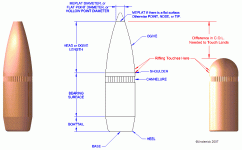FoghornLeghorn
New member
I'm loading some Nosler Ballistic Tip (Spitzer) 150 grain 30-06. (Starting load 55 grains IMR 4350.)
Nosler's website suggest 3.320 inches overall cartridge length for that bullet.
I've got some factory Remington 150 grain 30-06 PSP. They measure 3.1655 inches.
I have an Alliant manual that doesn't give data for Nosler 150 grain, but has the Hornady 150 grain Spire Point (that's Spitzer, right?) as 3.210 inches.
I have three 30-06 rifles. This is for a 2002 Remington 700 Mountain Rifle, and I've read that the bullet contacting the lands could create excessive pressures.
Nosler's website suggest 3.320 inches overall cartridge length for that bullet.
I've got some factory Remington 150 grain 30-06 PSP. They measure 3.1655 inches.
I have an Alliant manual that doesn't give data for Nosler 150 grain, but has the Hornady 150 grain Spire Point (that's Spitzer, right?) as 3.210 inches.
I have three 30-06 rifles. This is for a 2002 Remington 700 Mountain Rifle, and I've read that the bullet contacting the lands could create excessive pressures.

